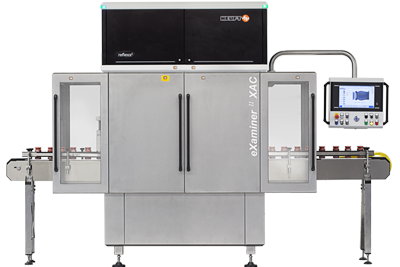An end to blind spots
Whether pickled food, fruit preserves, delicatessen, jams or baby food, whether in a jar or in a can: the HEUFT eXaminer XAC is far ahead of conventional X-ray scanners when inspecting the quality of filled food containers. The end of line system even examines oversized full containers completely. Blind areas where faults could be overlooked are therefore no longer an issue.
The HEUFT eXaminer XAC detects foreign objects with unrivalled care and precision for the very reason that it is the only system of its kind equipped with X-ray strobes and not with common X-ray generators. However the system demonstrates its true qualities where other manufacturers’ full container inspectors often reach their limits: during the complete inspection of particularly large-sized containers.
"Diameters as from 130 millimetres are the absolute maximum for many", states Dirk Henschke, HEUFT Product Manager X-ray Inspection. "By contrast we are capable of up to 155 millimetres." Food companies no longer have to fear blind spots and blind areas even when the containers are very tall. Foreign objects such as stones, pellets, pieces of metal from the cutter or glass splinters are reliably identified even in giant catering jars and five kilogram cans of food.
Multiple X-ray flash for full coverage
Because, on the one hand, the device can be equipped with several X-ray strobes which can be flexibly positioned. This makes the inspection of the complete height of the container and a 360 degree coverage of the whole base area possible. On the other hand, the system also provides a smart multiple flash option in order to examine the full volume of oversized cans of food completely and to reliably detect faults everywhere.
Mr Henschke explains: "We can flash several times with a single X-ray tube and as a result divide large containers up into different sectors. These individual areas are then easier to zoom in order to make minute faults visible. Finally new filter technologies make it possible to fade out container structures such as embossing and orientation marks on jars or soldered seams on cans as well as product inhomogeneities."
Foreign object detection and fill level detection rolled into one
Deviations to the filling quantity can even be detected besides foreign objects and defects. "We are the only supplier capable of always looking at the fill level with an exact alignment and without distortion, regardless of the height of the container, because the individual X-ray strobes can be flexibly positioned", according to Mr Henschke. "There is a risk of blind areas if this is not the case." The dynamic HEUFT nbx filters facilitate the identification of rough underfills – the fill level is outside the filter mask if it is too low. This technology, integrated as standard, is extremely useful particularly in the case of pickled food where an insufficient amount of pickle causes the product to spoil prematurely.
The range of functions of the HEUFT eXaminer XAC can be extended by means of an additional X-ray measuring bridge for those who want even more precision. "It scans the fill level several times and determines the average of the filling quantity of complete batches", explains Mr Henschke. "Consequently we are able to fulfil the legal requirements regarding the average filling quantity of finished packaging." The use of productivity-decreasing check weighers is even superfluous depending on the characteristics of the product and the packaging.



